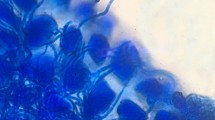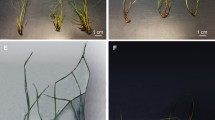Abstract
Improving micropropagation success rate is important since this technique allows the development of other biotechnological tools, such as genetic transformation, in vitro polyploidization, or endophyte inoculation. This is particularly relevant for grasses, as they are traditionally considered recalcitrant to plant tissue culture. Grasses of the subfamily Pooideae establish mutualistic associations with grass endophyte fungi of the genus Epichloë. These associations are specific, as each host species is associated with one or few Epichloë species. Lolium arundinaceum (Schreb.) Darbysh. is a perennial C3 species, native to Europe, which has become an important cool season forage crop worldwide. This grass usually establishes beneficial symbioses with E. coenophiala, but these benefits depend on both plant and fungal genetics and environmental conditions. Micropropagation protocols have been published for L. arundinaceum, but the influence of Epichloë endophytes was never examined. The aim of this manuscript was to study the effect of E. coenophiala on different micropropagation stages of L. arundinaceum and growth of the regenerated plantlets. Association with E. coenophiala (E+) increased callus induction, enhanced their proliferation, and increased shoot regeneration in L. arundinaceum. However, the biomass of plantlets regenerated from E+ seeds was lower than from non-associated seeds, both in vitro and ex vitro, and the in vitro multiplication rate also decreased. Contrary to other endophyte Epichloë-host associations with Lolium multiflorum and Bromus auleticus, the association with E. coenophiala did not improve tall fescue micropropagation. We can conclude that the effects of Epichloë endophytes on micropropagation and growth of their host differ for each endophyte-host association.


Similar content being viewed by others
Data availability
(Not applicable)
References
Arechavaleta M, Bacon CW, Hoveland CS, Radeliffe DE (1989) Effect of tall fescue endophyte on plant response to environmental stress. Agron J 81:83–90
Bacon CW, Porter JK, Robbins JD, Luttrell ES (1977) Epichloë typhina from toxic tall fescue grasses. Appl Environ Microbiol 34:576–581
Bai Y, Qu R (2001) An evaluation of callus induction and plant regeneration in twenty-five turf-type tall fescue (Festuca arundinacea Schreb.) cultivars. Grass Forage Sci 55:326–330
Bastías DA, Martínez-Ghersa MA, Ballaré CL, Gundel PE (2017) Epichloë fungal endophytes and plant defences: not just alkaloids. Trends Plant Sci 22:939–948
Bourguignon M, Nelson JA, Charlisle E, Ji H, Dinkins RD, Phillips TD, McCulley RL (2015) Ecophysiological responses of tall fescue genotypes to fungal endophyte infection, elevated temperature, and precipitation. Crop Sci 55:2895–2909
Bouton JH, Gates RN, Belesky DP, Owsley M (1993) Yield and persistence of tall fescue in the south-eastern coastal plain after removal of its endophyte. Agron J85:52–55
Bouton JH, Gates RN, Hoveland CS (2001) Selection for persistence in endophyte-free Kentucky 31 tall fescue. Crop Sci 41:1026–1028
Cheplick GP, Clay K, Marks S (1989) Interactions between infection by endophytic fungi and nutrient limitation in the grasses Lolium perenne and Festuca arundinacea. New Phytol 111:89–97
Christensen MJ, Saulsbury K, Simpson WR (2012) Conspicuous epiphytic growth of an interspecific hybrid Neotyphodium sp. endophyte on distorted host inflorescences. Fungal Biol 116:42–48
Elmi AA, West CP (1995) Endophyte infection effects on stomatal conductance osmotic adjustment and drought recovery of tall fescue. New Phytol 131:61–67
Giri CC, Praveena M (2015) In vitro regeneration, somatic hybridization and genetic transformation studies: an appraisal on biotechnological interventions in grasses. Plant Cell Tissue Organ Cult 120:843–860
Gundel PE, Pérez LI, Helander M, Saikkonen K (2013) Symbiotically modified organisms: non-toxic fungal endophytes in grasses. Trends Plant Sci 18:420–427
Hoveland CS (1993) Importance and economic significance of the Acremonium endophytes to performance of animals and grass plant. AgroEcosyst Environ 44:3–12
Hume DE, Ryan G, Gibert A, Helander M, Mirlohi A, Sabzalian MR (2016) Epichloë fungal endophytes for grassland ecosystems. In: Lichtfouse E (ed) Sustainable Agriculture Reviews, vol 19. Springer, Cham. https://doi.org/10.1007/978-3-319-26777-7_6
Iannone LJ, Cabral D (2006) Effects of the Neotyphodium endophyte status on plant performance of Bromusauleticus, a wild native grass from South America. Symbiosis 41:61–69
Iannone LJ, White JF, Giussani LM, Cabral D, Novas MV (2011) Diversity and distribution of Neotyphodium-infected grasses in Argentina. MycolProg 10:9–19
Iannone LJ, Vignale MV, Pinget AD, Re A, Novas MV (2017) Seed-transmitted Epichloë sp. endophyte alleviates the negative effects of head smut of grasses (Ustilago bullata) on Bromus auleticus. Fungal Ecol 29:45–51
Kalosa-Kenyon E, Slaughter LC, Rudgers JA, Mc Culley R (2018) Asexual Epichloë endophytes do not consistently alter arbuscular mycorrhizal fungi colonization in three grasses. Am Midl Nat 179:157–165
Lee KW, Choi GJ, Kim K, Ji HC, Park H, Seo SB, Kim MJ, Lee SH (2012) Comparison of callus induction and plant regeneration from twenty fall fescue varieties. Afr J Biotechnol 11:3553–3557
Leuchtmann A, Bacon CW, Schardl CL, White JF, Tadych M (2014) Nomenclatural realignment of Neotyphodium species with genus Epichloë. Mycologia 106:202–215
Maddaloni J, Ferrari L (2005) Forrajeras y Pasturas Del Ecosistema Templado Húmedo De La Argentina. Instituto Nacional de TecnologíaAgropecuaria, Buenos Aires
Moon CD, Miles CO, Järlfors U, Schardl CL (2002) The evolutionary origins of three new Neotyphodium endophyte species from grasses indigenous to the Southern Hemisphere. Mycologia 94:694–711
Moore JD, Carlisle AE, Nelson JA, Mc Culley RL (2019) Fungal endophyte infection increases tall fescue's survival, growth, and flowering in a reconstructed prairie. RestorEcol 27:1000–1007
Moy M, Belanger F, Duncan R, Freehoff A, Leary C, Meyer W, Sullivan R, White JF Jr (2000) Identification of epiphyllous mycelial nets on leaves of grasses infected by clavicipitaceous endophytes. Symbiosis 28:291–302
Murashige T, Skoog F (1962) A revised medium for rapid growth and bio assays with tobacco tissue cultures. Physiol Plant 15(3):473–4497
Nave RLG, Barbero RP, Boyer CN, Corbin MD, Bates GE (2016) Nitrogen rate and initiation date effects on stockpiled tall fescue during fall grazing in Tennessee. Crop Forage Turf Manage 2:2015–0174. https://doi.org/10.2134/cftm2015.0174
Novas MV, Iannone LJ, Godeas AM, Scervino JM (2011) Evidence for leaf endophytes regulation on root symbionts: effect of Neotyphodium endophytes on the pre-infective state of mycorrhizal fungi. Symbiosis 51:19–28
Ran Y, Patron N, Yu Q, Georges S, Mason J, Spangenberg G (2014) Agrobacterium-mediated transformation of Lolium rigidum Gaud. Plant Cell Tissue Organ Cult 118:67–75
Regalado JJ, Vignale MV, Novas MV, Pitta-Alavarez SI, Iannone LJ (2017) Epichloë occultans improve the Lolium multiflorum micropropagation. Plant Cell Tissue Organ Cult 130:37–46
Regalado JJ, Berdion MV, Vignale MV, Novas MV, Pitta-Alvarez SI, Iannone L (2018) The presence of Epichloë sp. in Bromu sauleticus(Trin.) seeds enhances micropropagation and growth of micropropagated plantlets from these seeds. Plant Cell Tissue Organ Cult 135:279–286
Saikkonen K, Wäli P, Helander M, Faeth SH (2004) Evolution of endophyte–plant symbioses. Trends Plant Sci 9:275–280
Scheneiter JO, Kaufmann I, Ferreyra AR, Llorente RT (2015) The herbage productivity of tall fescue in the Pampas region of Argentina is correlated to its ecological niche. Grass Forage Sci 71:403–412
Song G, Walworth A, Hancock JF (2012) Factors influencing Agrobacterium-mediated transformation of switchgrass cultivars. Plant Cell Tissue Organ Cult 108:445–453
Tadych M, Bergen MS, White JF Jr (2014) Epichloë spp. associated with grasses: new insights on life cycles, dissemination and evolution. Mycologia. 106:181–201
Tian Z, Wang R, Ambrose KV, Clarke BB, Belanger FC (2017) The Epichloë festucae antifungal protein has activity against the plant pathogen Sclerotinia homoeocarpa, the causal agent of dollar spot disease. Sci Rep 7:5643
Vignale MV, Astiz-Gasso MM, Novas MV, Iannone LJ (2013) Epichloid endophytes confer resistance to the smut Ustilago bullata in the wild grass Bromus auleticus (Trin.). Biol Control 67:1–7
Vignale MV, Iannone LJ, Scervino JM, Novas MV (2018) Epichloë exudates promote in vitro and in vivo arbuscular mycorrhizal fungi development and plant growth. Plant Soil 422:267–281
Vignale MV, Iannone LJ, Novas MV (2020) Epichloë endophytes of a wild grass promote mycorrhizal colonization of neighbor grasses. Fungal Ecol. https://doi.org/10.1016/j.funeco.2020.100916
Wang X, QinJ CW, Zhou Y, Ren A, Gao Y (2016) Pathogen resistant advantage of endophyte-infected over endophyte-free Leymus chinensis is strengthened by pre-drought treatment. Eur J Plant Pathol 144:477–486
Wiewiora B, Zúrek GZ, Zúrek M (2015) Endophyte-mediated disease resistance in wild populations of perennial ryegrass (Lolium perenne). Fungal Ecol 15:1–8
Xia C, Zhang X, Christensen MJ, Nan Z, Li C (2016) Epichloë endophyte affects the ability of powdery mildew (Blumeria graminis) to colonise drunken horse grass (Achnatherum inebrians). Fungal Ecol 16:26–34
Zhang W, Dong J, Liang B, Jin Y, Wang T (2006) Highly efficient embryogenesis and plant regeneration of tall fescue (Festuca arundinacea Schreb.) from mature seed-derived calli. In Vitro Cell Dev-Pl 42:114–118
Zhang K, Wang J, Hu X, Yang A, Zhang J (2010) Agrobacterium mediated transformation of shoot apices of Kentucky bluegrass (Poapratensis L.) and production of transgenic plants carrying a betA gene. Plant Cell Tissue Organ Cult 102:135–143
Funding
This work was supported by funding from Agencia Nacional de Promoción Científica y Tecnológica (PICT Joven 2016-0487, PICT 2016-0877, PICT 2016-0980, PICT 2018-4436), CONICET (Consejo Nacional de Investigaciones Científicas y Técnicas, Argentina) Grant PIP 11220150100956CO, and from Universidad de Buenos Aires UBACyT (20020150100067BA and 20020170100598BA).
Author information
Authors and Affiliations
Contributions
RJJ designed and carried out the in vitro micropropagation protocol and wrote the manuscript. BV carried out in vitro micropropagation and plantlet acclimatization. TVE supervised plantlet acclimatization and ex vitro growth analysis and critical revision of the manuscript. ILJ provided and characterized the starting plant material and critical revision of the manuscript. PASI designed the in vitro micropropagation protocol and supervised the English edition of the manuscript. NMV supervised and coordinated the research and wrote the manuscript.
Corresponding authors
Ethics declarations
Conflicts of interest
The authors declare that they have no conflict of interest.
Ethics approval
Not applicable
Consent to participate
All the authors have given their consent to participate in this work.
Consent for publication
All the authors have given their consent for the publication of this work.
Code availability
(Not applicable)
Additional information
Section Editor: Marc Stadler
Publisher’s note
Springer Nature remains neutral with regard to jurisdictional claims in published maps and institutional affiliations.
Electronic supplementary material
Fig. S1
Callus induction in Lolium arundinaceum seeds: A) associated with Epichloë coenophiala B) not associated with Epichloë coenophiala. Calli obtained from Lolium arundinaceum seeds: C) associated with Epichloë coenophiala D) not associated with Epichloë coenophiala. Shoots regenerated from callus obtained from F. arundinacea seeds: E) associated with Epichloë coenophiala F) and not associated with Epichloë coenophiala. (PNG 53368 kb)
Rights and permissions
About this article
Cite this article
Regalado González, J.J., Berdion, V., Tossi, V.E. et al. Influence of Epichloë coenophiala, a seed-borne endophyte, on the micropropagation of tall fescue. Mycol Progress 19, 1301–1308 (2020). https://doi.org/10.1007/s11557-020-01627-y
Received:
Revised:
Accepted:
Published:
Issue Date:
DOI: https://doi.org/10.1007/s11557-020-01627-y




